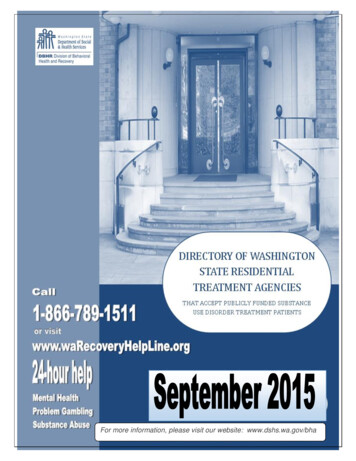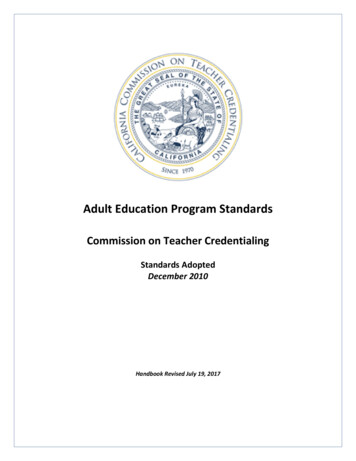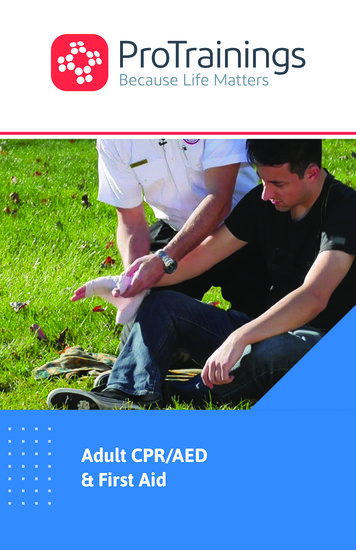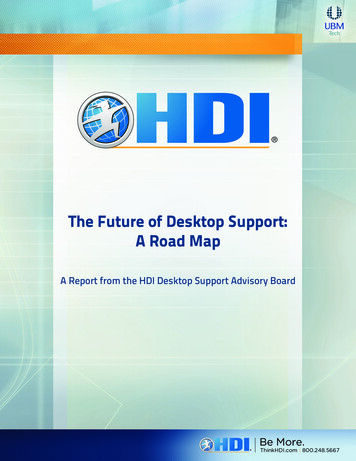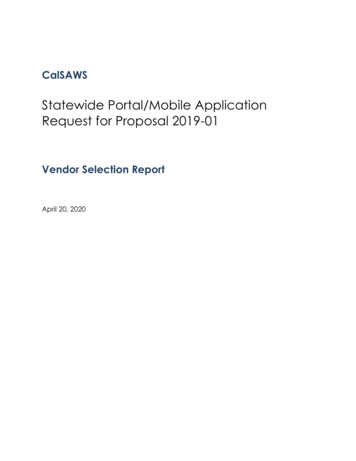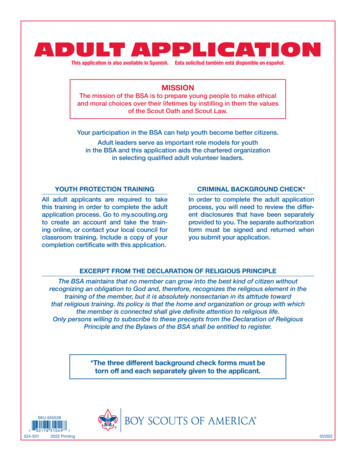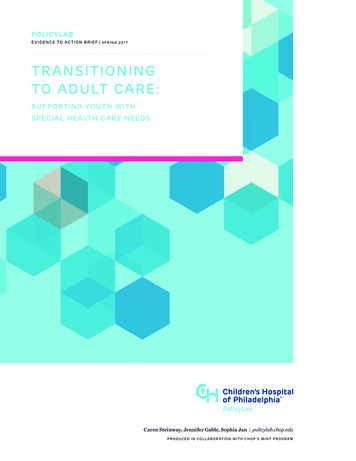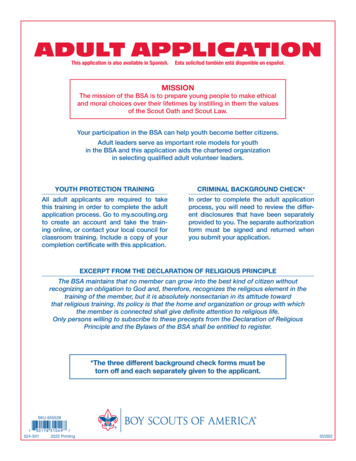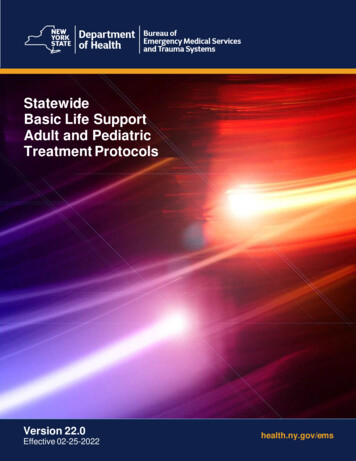
Transcription
StatewideBasic Life SupportAdult and PediatricTreatment ProtocolsVersion 22.0Effective 02-25-2022health.ny.gov/ems
IndexBackground . 4Introduction . 5Pediatric Definition and Discussion . 7Acknowledgements . 8General Approach to Prehospital Care . 9General Approach to the EMS Call . 10General Approach to the Patient . 11General Approach to Transportation . 14General Approach to Safety Restraining Devices . 15Extremis/Cardiac Arrest Protocols. 16Cardiac Arrest . 17Cardiac Arrest – Pediatric . 19Foreign Body Obstructed Airway . 21Foreign Body Obstructed Airway – Pediatric. 22Respiratory Arrest/F ailure . 23Respiratory Arrest/F ailure – Pediatric . 24Obvious Death. 25General Adult and Pediatric Medical Protocols . 26AMS: Altered Mental Status . 27AMS: ALTE/BRUE – Pediatric. 28Anaphylaxis . 29Anaphylaxis – Pediatric . 30Behavioral Emergencies . 32Carbon Monoxide Exposure – Suspected. 333Cardiac Related Problem . 35Cardiac Related Problem – Pediatric . 36Childbirth: Obstetrics . 38Childbirth: Newborn/Neonatal Care. 40Difficulty Breathing: Asthma/Wheezing . 41Difficulty Breathing: Asthma/Wheezing – Pediatric . 43Difficulty Breathing: Stridor – Pediatric . 45Environmental – Cold Emergencies . 46Environmental – Heat Emergencies . 48Opioid (Narcotic) Overdose . 49Version 22.0 Effective 02-25-20221
Poisoning. 50Seizures . 51Sepsis/Septic Shock. 52Sepsis/Septic Shock – Pediatric. 53Stroke . 54Technology Assisted Children . 55Total Artificial Heart (TAH) . 57Ventricular Assist Device (VAD) . 58Trauma Protocols. 60Trauma Patient Destination . 61Amputation . 62Avulsed Tooth . 63Bleeding/Hemorrhage Control . 64Burns . 66Chest Trauma. 68Eye Injuries. 69Musculoskeletal Trauma . 70Patella Dislocation . 71Suspected Spinal Injuries . 72Resources. 74Advance Directives/DNR/MOLST . 75APGAR . 77Automatic Transport Ventilator . 78Child Abuse Reporting . 80Glasgow Coma Score (GCS) . 81Incident Command . 82Needlestick/Infectious Exposure . 83Normal Vital Signs for Infants/Children. 84Oxygen Administration . 85Pediatric Assessment Triangle . 86Prescribed Medication Assistance . 87Refusal of Medical Attention. 88Responsibilities of Patient Care . 90Transfer of Patient Care . 91Version 22.0 Effective 02-25-20222
Version 22.0 Effective 02-25-20223
BackgroundThese protocols are intended to guide and direct patient care by EMS providers across NewYork State. They reflect the current evidence-based practice and consensus of contentexperts. These protocols are not intended to be absolute treatment documents, rather, asprinciples and directives which are sufficiently flexible to accommodate the complexity ofpatient management.No protocol can be written to cover every situation that a provider may encounter, nor areprotocols a substitute for good judgment and experience. Providers are expected to utilizetheir best clinical judgment and deliver care and procedures according to what isreasonable and prudent for specific situations. However, it will be expected that anydeviations from protocol shall be documented and reviewed, according to regionalprocedure.THESE PROTOCOLS ARE NOT A SUBSTITUTEFOR GOOD CLINICAL JUDGEMENTVersion 22.0 Effective 02-25-20224
IntroductionThe Statewide Basic Life Support Adult and Pediatric Treatment Protocols reflect thecurrent acceptable standards for basic life support (BLS) delivered by certified firstresponders (CFR), and emergency medical technicians (EMT) in New York State.Advanced life support (ALS) protocols are developed separately and subject to regionalvariation.Advanced providers are also responsible for, and may implement, the standing ordersindicated for BLS care. Protocols are listed for each provider level and STOP lines indicatethe end of standing orders. Generally, BLS interventions should be completed before ALSinterventions.Bullets are used throughout this document. Many processes are not sequential and tasksshould be performed as most appropriate for patient care.Regional protocols and policies may accompany these BLS protocols.The color-coded format of the protocols allows each BLS professional to easily follow thepotential interventions that could be performed by level of certification.CRITERIA Any specific information regarding the protocol in generalCFR AND ALL PROVIDER LEVELS CFR and EMT standing ordersThese are also standing orders for all levels of credential above EMTCFR STOPEMT EMT standing ordersThese are also standing orders for all levels of credential above EMTEMT STOPMEDICAL CONTROL CONSIDERATIONS Options listed in this section are common considerations that medical control maychoose to order as the situation warrantsKEY POINTS/CONSIDERATIONS These protocols do not supplant regionally required equipment specifications or theitems required under Public Health Law and RegulationsVersion 22.0 Effective 02-25-20225
These protocols should not serve as a demonstration of required equipment ortraining, as regional and agency variations will exist“*if equipped and trained” is noted to indicate interventions that may be performed if anagency or region chooses to implement these variations. These are not required.Version 22.0 Effective 02-25-20226
Pediatric Definition and DiscussionThe period of human development from childhood to adulthood is a continuum with thetransition occurring during puberty. Since the completion of this transition is not sharplydemarcated and varies among individuals, it is difficult to set a precise age when childhoodends and adulthood begins. It follows that use of such a definition to determine when apediatric or an adult protocol is to be used is also problematic.The medical control agreement contained within these protocol document states, “providersare expected to utilize their best clinical judgment and deliver care and proceduresaccording to what is reasonable and prudent for specific situations.” The determination ofwhen to utilize an adult or pediatric protocol shall be no different and subject to the sameCQI review that is compulsory with any other aspect of prehospital emergency care.As a general guideline for use with these protocols, the following definition has beenestablished: Pediatric protocols should be considered for patients who have not yet reachedtheir 15th birthdayVersion 22.0 Effective 02-25-20227
AcknowledgementsThe State and Regional Emergency Medical Services Councils, State and RegionalEmergency Medical Advisory Committees, State Emergency Medical Services for ChildrenAdvisory Committee, Regional Program Agency staff, and all who contributed to this andprevious versions of these protocols.The BLS Protocols Advisory and Writing Group.NYSDOH Bureau of EMS staff.Special thanks to Robin Snyder-Dailey for the protocol design.Version 22.0 Effective 02-25-20228
General Approach to Prehospital CareVersion 22.0 Effective 02-25-20229
General Approach to the EMS CallApplies to adult and pediatric patientsCRITERIAThis general approach guidance document is intended to provide a standardized frameworkfor approaching the scene. Follow common sense, apply good clinical judgment, and followregionally approved polices and protocols.CFR AND ALL PROVIDER LEVELSEMTConsider dispatch information while responding: Type of response(emergency/non) Prevailing weather Road conditions Time of day Location of callEMD determinant/mechanismof illness/injuryNumber of anticipated patientsNeed for additional resourcesSurvey the scene – do not approach the scene unless acceptably safe to do so. Stageproximate to the scene until scene is rendered acceptably safe: Environmental hazards Mechanical hazards CBRNE hazards Violence/threat of violence Evidence of unknown Traffic hazardspowders/other Number of actual patientsunknown substances/sharps Activate local MCI plan as Indicators of a chemical suicidenecessaryConsider shelter-in-place or evacuation based on hazards; consider additional supportresources: ALS intercept Fire department/heavy rescue Additional ambulance Law enforcement Air medical services Utilities EMS physicianEnsure universal precautions/personal protective equipment appropriate to the task.For situations in which EMS PPE would not sufficiently protect the provider, theprovider should assist the other emergency responders in determining responseobjectives based on life safety, property preservation, and environmental protection.Establish or participate in unified command or ICS structure, as appropriate.For MCIs, establish a command structure as soon as possible.Version 22.0 Effective 02-25-202210
General Approach to the PatientApplies to adult and pediatric patientsCRITERIAThis general approach guidance document is intended to provide a standardized frameworkfor approaching the patient. Follow common sense, apply good clinical judgment, and followregionally approved polices and protocols.CFR AND ALL PROVIDER LEVELSEMTHistory of present illness What events led up to the EMS contact? Use SAMPLE, OPQRST or similar to guide approach to events/illness/complaint Pertinent past medical history/medications/allergies Obtain additional pertinent medical information from the family and bystandersPhysical exam Focused or complete exam directed by patient presentation, chief complaint, andmechanism of injury or illness Check for medical alert tagsPatient examination – primaryIdentify and treat apparent life-threats including massive hemorrhageAirway Identify and correct any existing or potential airway obstruction while protecting thecervical spine if appropriate Is the airway patent? Will it stay open on its own? Is intervention (OPA, NPA, suction) necessary?Breathing Apply oxygen and/or positive pressure ventilations, as indicated See “Resources: Oxygen Administration” protocol Is breathing present? Is breathing too fast or too slow to sustain life? Is the patient speaking effectively?Circulation Control serious life-threatening hemorrhage immediately upon discovery Refer to the “Trauma: Bleeding/Hemorrhage Control” protocol Is a pulse present? Is the pulse too fast or too slow to sustain life? Is the pulse regular or irregular?Version 22.0 Effective 02-25-202211
What is the skin color, condition, and temperature?Is there serious external hemorrhage?Is there evidence of internal hemorrhage or signs of shock?Continually reassess and correct any existing or potentially compromising threats to theABCsDisability Determine level of consciousness Alert, Voice, Pain, Unresponsive (AVPU) GCS Pupils Cincinnati Pre-Hospital Stroke Screen (or other regionally approved strokescale)Expose Appropriately expose patient as needed to perform complete physical exam andperform necessary interventions Are exposed patients sufficiently protected from public view?Transport Decision See “General Approach: to Transportation” protocolSecondary patient assessment Vital signs (repeated frequently if abnormal or critical patient) Pulse rate and quality Respirations rate and quality Blood pressure Obtain BP by palpation only if necessary Skin color, condition, and temperature Blood glucose determination, if approved, equipped, and appropriateLocate records including: MOLST, eMOLST, or DNR as appropriateMEDICAL CONTROL CONSIDERATIONS Medical control may give any order within the scope of practice of the providerOptions listed in this section are common considerations that medical control maychoose to order as the situation warrantsKEY POINTS/CONSIDERATIONS If a patient chooses to refuse care or transportation, please refer to “Resources:Refusal of Medical Attention” protocol and regional policyDevelop a prehospital patient impression by combining all information available in thehistory of present illness, past medical history, and physical examSubmit a verbal report to the responsible medical personnel upon arrival at theemergency departmentVersion 22.0 Effective 02-25-202212
Label any items that were transported with the patient such as ECGs, paperwork fromfacilities, medications, or belongingsComplete a patient care report in compliance with state, regional, and agency policyVersion 22.0 Effective 02-25-202213
General Approach to TransportationApplies to adult and pediatric patientsCRITERIAThis general approach guidance document is intended to provide a standardized frameworkfor patient transport. Follow common sense, apply good clinical judgment, and followregionally approved policies and procedures.CFR AND ALL PROVIDER LEVELSEMTOngoing scene and patient assessment Scene safety is not just a yes/no question; it involves continual situational awareness Take note of the effect of patients and bystanders Don’t get pinned into area Be aware of your egress routesConsideration for ALS intercept and air medical services should be made based on agencyand regional protocol, policy, patient needs, regional capabilities, and travel times. Do notdelay transport waiting for ALS to arrive. The closest ALS may be at a facilityTransport to the closest appropriate receiving facility in accordance with regional facilitydestination policies for travel time, facility capabilities, and NY State designation The closest appropriate facility may not be the nearest facility even for patients inextremis such as those in cardiac or respiratory arrestEnsure ongoing patient assessment, check for improving / deteriorating patient condition,and respond accordingly. Check to ensure that previously initiated therapies remainfunctionalCarefully consider use of appropriate emergency warning devices for transport:Lights and siren use is a medical intervention – does the patient condition warrant the use?Provide a brief pre-arrival report to receiving facility in accordance with regional policy.Ensure early notification for serious trauma, STEMI, stroke, and sepsisMEDICAL CONTROL CONSIDERATIONS Medical control may assist with questions regarding patient care or if there arecomplex medical conditions requiring additional guidanceMedical control may assist with the determining the most appropriate receiving facilityKEY POINTS/CONSIDERATIONS If a patient chooses to refuse care or transportation, please refer to “Resources:Refusal of Medical Attention” protocol, as well as agency and regional policyVersion 22.0 Effective 02-25-202214
General Approach to Safety Restraining DevicesApplies to adult and pediatric patientsCRITERIAThis general approach guidance document is intended to provide a standardized frameworkfor patient transport. Follow common sense, apply good clinical judgment, and followregionally approved policies and procedures.CFR AND ALL PROVIDER LEVELSEMTAll passengers including patients and EMS personnel should be restrained It is not permissible or safe to have a parent or caregiver hold a child in his or her armsor lap. The child and parent/caregiver should each be restrained appropriatelyAll patients on the stretcher must be secured when the vehicle is in motion or thestretcher is being carried or moved; stretcher harness straps should always be usedA child’s own safety seat – when available and intact – can be used to restrain a childduring transport. He or she should be placed in the device and the device should bebelted to an ambulance seat. If the child is the patient, the seat should be securedonto the stretcher and the child belted in the child safety seatIf the ambulance service does not have an ambulance equipped with child safetyseats or restraint, it is recommended that the agency purchase approved child safetyseat(s) or restraint(s) for each ambulance. More than one size seat/restraint may beneeded as location of the restraint (i.e., stretcher, or captain’s chair) may notaccommodate all size childrenAgencies should routinely train EMS personnel in the use of various child safetyseats/restraints available and have a policy for how injured and uninjured children willbe transportedAs an agency considers the purchase of new vehicles, or is retrofitting currentvehicles, design considerations, such as integrated child restraints, should beconsideredAll safety seats/restraints should be used according to manufacturer’srecommendationsKEY POINTS/CONSIDERATIONS If a patient chooses to refuse safety restraints, please refer to “Resources: Refusal ofMedical Attention” protocol, as well as agency and regional policyVersion 22.0 Effective 02-25-202215
Extremis/Cardiac Arrest ProtocolsVersion 22.0 Effective 02-25-202216
Cardiac ArrestFor pediatric, see “Cardiac Arrest – Pediatric”CRITERIA For patients who are unresponsive without signs of lifeFor patients that do not meet the criteria of “Extremis: Obvious Death” protocol orotherwise excluded by a DNR/MOLST order, see also “Resources: AdvanceDirectives/MOLST/DNR” protocolCFR AND ALL PROVIDER LEVELS CPR should be initiated prior to defibrillation unless the cardiac arrest is witnessed bythe responding EMS provider Perform compressions while awaiting the application of defibrillation padsPush hard and fast (100-120 compressions/min) Metronome or feedback devices may be usedEnsure full chest recoilMinimize interruptions in chest compressionsCycle of CPR 30 compressions then 2 breaths 5 cycles 2 minutes Rotate compressors every two minutes with pulse checks, as resources allow Minimize interruptions in chest compressionsContinuous compressions with asynchronous ventilation (not stopping compressionswhile ventilating) is permitted to substitute for cycles of CPR that have pauses forventilation even in non-intubated patientsAvoid hyperventilation (breathing too quickly or deeply for the patient)Use of airway adjuncts and bag-valve mask device, as indicated, with BLS airwaymanagement, including suction (as needed), as available Bag-valve mask should be connected to supplemental oxygen, if availableRhythm check or AED “check patient” every 5 cycles or two minutes of CPRDefibrillate as appropriate Resume CPR immediately after defibrillation (do not check a pulse at thistime) Continue CPR for approximately 2 minutes cycles before doing a pulse check,or until the patient no longer appears to be in cardiac arrestCFR STOPEMT After 20 minutes consider calling medical control for: termination of resuscitation,continuing efforts, or transportation in extenuating circumstancesEMT STOPMEDICAL CONTROL CONSIDERATIONS Termination of resuscitation in instances that are not covered by standing order criteriamay be authorized by medical controlVersion 22.0 Effective 02-25-202217
KEY POINTS/CONSIDERATIONS Do not interrupt compressions for placement of an advanced airwayMinimize interruption in compressions for placement of a mechanical CPR deviceDo not delay beginning compressions to begin ventilationsDo not delay ventilations to connect supplemental oxygenAdequate ventilation may require disabling the pop-off valve is the bag-valve maskunit is so equippedAED should be placed as soon as possible without interrupting compressions to do soIf a patient has a medication patch, it may be removed (use appropriate PPE)Artifact from vibrations in a moving ambulance may compromise the effectiveness ofthe AEDCompressions in moving ambulances pose a significant danger to providers, are lesseffective, and should be avoided Consider mechanical CPR devices when available for provider safety if thereis a need to do compressions in moving ambulances (e.g. AutoPulse ,LUCAS , LifeStat , or other FDA approved device)Version 22.0 Effective 02-25-202218
Cardiac Arrest – PediatricCRITERIA For patients who are unresponsive without signs of lifeFor patients that do not meet the criteria of “Extremis: Obvious Death” protocol orotherwise excluded by a DNR/MOLST orderCFR AND ALL PROVIDER LEVELSEMT CPR should be initiated prior to defibrillation unless the cardiac arrest is witnessed bythe responding EMS provider Perform compressions while awaiting the application of defibrillation padsPush hard and fast (100-120 compressions/min) Metronome or feedback devices may be usedEnsure full chest recoilMinimize interruptions in chest compressionsCycle of CPR 30 compressions then 2 breaths (single rescuer)15 compressions then 2 breaths (if two rescuers available) 5 cycles 2 minutes (10 cycles 2 minutes for 2-rescuers) Rotate compressors every two minutes with pulse checks, as resources allow Minimize interruptions in chest compressionsAvoid hyperventilationUse of airway adjuncts and bag-mask device (BVM), as indicated, with BLS airwaymanagement, including suction (as needed), as available Bag-mask should be connected to supplemental oxygen, if availableRhythm check or AED “check patient” every two minutes of CPRDefibrillate as appropriate (Pediatric AED pads preferred for children with weight 25kg or age 8 years, if available.) Resume CPR immediately after defibrillation (do not check a pulse at thistime) Continue CPR for approximately 2 minutes cycles before doing a pulse check,or until the patient no longer appears to be in cardiac arrestCFR AND EMT STOPMEDICAL CONTROL CONSIDERATIONS Termination of resuscitation in instances that are not covered by standing order criteriamay be authorized by medical controlKEY POINTS/CONSIDERATIONS Do not delay beginning compressions to begin ventilationsDo not delay ventilations to connect supplemental oxygenAdequate ventilation may require disabling the pop-off valve if the bag mask unit is soequippedVersion 22.0 Effective 02-25-202219
AED should be placed as soon as possible without interrupting compressions to do soArtifact from vibrations in a moving ambulance may compromise the effectiveness ofthe AEDCompressions in moving ambulances pose a significant danger to providers, are lesseffective and should be avoided If appropriate for the patient’s size, consider mechanical CPR devices whenavailable for provider safety if there is a need to do compressions in movingambulances (e.g. AutoPulse , LUCAS , LifeStat , or other FDA approveddevice) Note: The use of a particular mechanical CPR device may be contraindicatedin the pediatric patient; refer to manufacturer’s recommendationVersion 22.0 Effective 02-25-202220
Foreign Body Obstructed AirwayFor pediatric, see “Foreign Body Obstructed Airway – Pediatric”CRITERIA Patients with a partial or complete foreign body airway obstructionCFR AND ALL PROVIDER LEVELSEMT If the patient is conscious and can breathe, cough, or speak Encourage the patient to cough Transport in a sitting position or other position of comfort Administer supplemental oxygen; refer to the “Resources: OxygenAdministration” protocolFacilitate transportation, ongoing assessment, and supportive care Perform ongoing assessment and watch for progression to completeobstructionIf the patient is conscious and cannot breathe, cough, or speak Perform airway maneuvers according to current AHA/ARC/NSSC guidelinesIf the patient is unconscious Remove any visible airway obstruction by hand Perform CPRCFR AND EMT STOPKEY POINTS/CONSIDERATIONS Do not delay transportVersion 22.0 Effective 02-25-202221
Foreign Body Obstructed Airway – PediatricCRITERIA Patients with a partial or complete foreign body airway obstructionCFR AND ALL PROVIDER LEVELSEMT If the patient is conscious and can breathe, cough, or speak Encourage the patient to cough Transport in a sitting position or other position of comfort Administer supplemental oxygen; refer to the “Resources: OxygenAdministration” protocol Consider allowing parent to hold face mask with oxygen 6-8 inches from thechil
The Statewide Basic Life Support Adult and Pediatric Treatment Protocols reflect the current acceptable standards for basic life support (BLS) delivered by certified first responders (CFR), and emergency medical technicians (EMT) in New York State. Advanced life support (ALS) protocols are developed separately and subject to regional variation.

